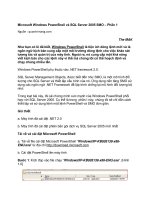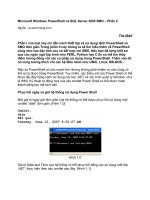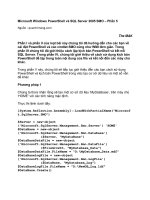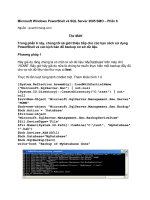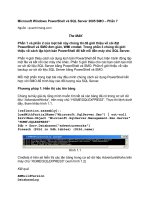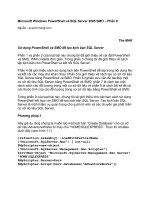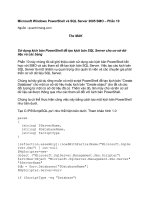Microsoft Windows Powershell 3.0 First Look potx
Bạn đang xem bản rút gọn của tài liệu. Xem và tải ngay bản đầy đủ của tài liệu tại đây (5.96 MB, 200 trang )
www.it-ebooks.info
Microsoft Windows PowerShell
3.0 First Look
A quick, succinct guide to the new and exciting features
in PowerShell 3.0
Adam Driscoll
P U B L I S H I N G
professional expertise distilled
BIRMINGHAM - MUMBAI
www.it-ebooks.info
Microsoft Windows PowerShell 3.0 First Look
Copyright © 2012 Packt Publishing
All rights reserved. No part of this book may be reproduced, stored in a retrieval
system, or transmitted in any form or by any means, without the prior written
permission of the publisher, except in the case of brief quotations embedded in
critical articles or reviews.
Every effort has been made in the preparation of this book to ensure the accuracy
of the information presented. However, the information contained in this book is
sold without warranty, either express or implied. Neither the author, nor Packt
Publishing, and its dealers and distributors will be held liable for any damages
caused or alleged to be caused directly or indirectly by this book.
Packt Publishing has endeavored to provide trademark information about all of the
companies and products mentioned in this book by the appropriate use of capitals.
However, Packt Publishing cannot guarantee the accuracy of this information.
First published: October 2012
Production Reference: 1260912
Published by Packt Publishing Ltd.
Livery Place
35 Livery Street
Birmingham B3 2PB, UK.
ISBN 978-1-84968-644-0
www.packtpub.com
Cover Image by Tina Negus ()
www.it-ebooks.info
Credits
Author
Adam Driscoll
Reviewers
Chris Dent
Shay Levy
David Karapetyan
Acquisition Editor
Dhwani Devater
Lead Technical Editor
Susmita Panda
Technical Editor
Prasanna Joglekar
Project Coordinator
Yashodhan Dere
Proofreader
Linda Morris
Indexers
Hemangini Bari
Tejal Daruwale
Graphics
Manu Joseph
Production Coordinator
Nilesh R. Mohite
Cover Work
Nilesh R. Mohite
www.it-ebooks.info
About the Author
Adam Driscoll is a young and enthusiastic Software Developer and Team Lead at
Quest Software. Born and raised in Wisconsin, Adam attended Edgewood College
in Madison, WI and was hired shortly thereafter by Quest. He has experience in
authoring PowerShell modules and providers in both .NET and PowerShell, building
PowerShell development tools for developers and administrators and frequently
blogs about .NET technologies.
I would like to thank my mother and father for always believing in
me and supporting me. I wouldn't have been able to complete this
without them. I would also like to thank my family and friends for
providing encouragement throughout the process of writing this
book. Finally, I would like to thank Carrie Arnold and Shay Levy for
providing additional editorial guidance during the authoring of this
book. Their help ensured that the quality of the book was far beyond
what I could do alone.
www.it-ebooks.info
About the Reviewers
Chris Dent is an Automation Specialist with over 10 years experience working
with Microsoft and networking technologies. Chris has worked with PowerShell
since 2007 specialising in network protocols and management.
My thanks should go to my wife Emily, for her endless patience in
the face of incessant clattering from my keyboard in the evenings.
Shay Levy is a Systems Engineer working for a government institute in Israel. He
has over 20 years of experience, focusing on Microsoft server platforms, especially
on Exchange and Active Directory. For his contribution to the community he has
been awarded with the Microsoft Most Valuable Professional (MVP) award for
four years in a row. As a Microsoft Certied Trainer (MCT) he has taught numerous
courses at John Bryce training center, Israel's largest computer training center.
He is the Co-Founder and Editor of the PowerShellMagazine.com website and a
Co-Director of the PowerShellCommunity.org website. Shay was also a technical
reviewer of several books, including the Microsoft Exchange 2010 PowerShell
Cookbook from Packt publishing. He often covers PowerShell related topics on
his blog and you can also follow him on Twitter at
/>www.it-ebooks.info
Not unlike many programmers David Karapetyan stumbled into programming
while trying to attain a graduate degree in a related technical eld. In his case it
happened to be mathematics and while he enjoyed the abstractions and mental
gymnastics involved in proving theorems at the end of the day opening up a shell
and writing a Ruby script to demonstrate an edge case of some theorem was far
more satisfying. So after attaining a Masters degree in mathematics he entered the
eld of software testing and reliability and hasn't looked back. These days his tools
for quickly accomplishing a task are C# and PowerShell. He works at eSolar as a
Software Test Engineer verifying the proper functionality of software that controls
elds of heliostats at a concentrated solar power plant. The complicated nature of
the software and its high reliability requirements mean that there must be a lot of
automation in the verication and testing process in order to meet tight release
deadlines. As the software runs on Windows the right tool for maintaining the
testing and automation framework for verifying the software is PowerShell because
it integrates seamlessly with all the components that comprise the testing framework.
www.it-ebooks.info
www.PacktPub.com
Support les, eBooks, discount offers and more
You might want to visit www.PacktPub.com for support les and downloads related to
your book.
Did you know that Packt offers eBook versions of every book published, with PDF and ePub
les available? You can upgrade to the eBook version at www.PacktPub.com and as a print
book customer, you are entitled to a discount on the eBook copy. Get in touch with us at
for more details.
At www.PacktPub.com, you can also read a collection of free technical articles, sign up for a
range of free newsletters and receive exclusive discounts and offers on Packt books and eBooks.
Do you need instant solutions to your IT questions? PacktLib is Packt's online digital book
library. Here, you can access, read and search across Packt's entire library of books.
Why Subscribe?
• Fully searchable across every book published by Packt
• Copy and paste, print and bookmark content
• On demand and accessible via web browser
Free Access for Packt account holders
If you have an account with Packt at www.PacktPub.com, you can use this to access PacktLib
today and view nine entirely free books. Simply use your login credentials for immediate access.
Instant Updates on New Packt Books
Get notied! Find out when new books are published by following @PacktEnterprise on
Twitter, or the Packt Enterprise Facebook page.
www.it-ebooks.info
www.it-ebooks.info
Table of Contents
Preface 1
Chapter 1: Find What You're Looking for 5
The Show-Command cmdlet 7
Updatable contextual help 11
What help is made of 11
The Save-Help cmdlet 12
The Update-Help cmdlet 13
The Get-Help cmdlet 14
The auto-discovery cmdlet 15
Understanding cmdlet auto-discovery 17
Things to know about auto-discovery 18
Summary 22
Chapter 2: Usability Enhancements 23
The problem with Where-Object and ForEach-Object 24
Fixing the problem with Where-Object 25
Fixing the problem with ForEach-Object 29
Enhancements to tab completion 31
Improvements to Get-ChildItem 34
The problem with Get-ChildItem 35
A better Get-ChildItem 37
Summary 40
Chapter 3: Improved Administration 41
Scheduling jobs 42
Creating a job trigger 44
Viewing scheduled jobs in the Windows Task Scheduler 46
Delegated administration 48
www.it-ebooks.info
Table of Contents
[ ii ]
The need for a more robust system 49
Examining PowerShell session congurations 50
Modifying existing session congurations 51
Creating a delegated session conguration 53
Registering new session congurations 53
Connecting to a newly registered session conguration 54
Robust and resilient remote sessions 55
A long running example 55
Using resilient sessions 56
Experimenting with resilient sessions 59
Improved Restart-Computer 61
The enhanced Restart-Computer 61
Installing a product which requires a restart 62
Using the delay parameter 63
Using different communication protocols 63
Summary 64
Chapter 4: Windows Workow in PowerShell 65
Understanding Windows Workow 66
Integrating Windows Workow with PowerShell 68
First steps in workows 69
Workow common parameters 72
Workow as a job 74
Remote execution 75
Custom workow parameters 76
Scripts in workows 77
Working between workows 78
Parallel execution 80
Persisting data in workows 82
Limitations of PowerShell workows 83
Variable scope 83
No advanced function blocks 85
Activities that run only on the local machine 85
The cmdlets that have no activity implementation 85
Importing activities into PowerShell 86
Using PowerShell workows in Visual Studio 90
Adding a Microsoft workow activity assembly 90
Adding a custom PowerShell workow to Visual Studio 96
Summary 96
Chapter 5: Using the Common Informational Model 97
Introduction to the CIM IDE 98
Implementing a simple WMI provider 101
Adding a CIM Provider project 103
www.it-ebooks.info
Table of Contents
[ iii ]
The implementation details 103
Generating PowerShell metadata 105
Registering a WMI provider 107
Automatically creating provider cmdlets 109
Why new cmdlets to interact with WMI? 110
Differences between the CIM and WMI cmdlets 110
Cmdlet differences between CIM and WMI 111
Registering CIM events 113
Updating CIM instances 114
Exploring the new CIM cmdlets 116
CIM sessions 117
Creating new CIM instances 119
Working with associated classes 119
NanoWBEM 122
Summary 122
Chapter 6: New and Improved PowerShell Hosts 123
Installing the Windows PowerShell Web Access feature 124
Conguring the Windows PowerShell Web Access 127
Authorizing users 127
Accessing the PowerShell Web Access 128
Working with the PowerShell Web Access console 129
Additional input and output 130
Multiline statements 131
Enhancements to the PowerShell ISE 132
Intellisense 132
Snippets 135
Dening our own snippets 136
XML le syntax highlighting 138
Other editor enhancements 138
ISE options 140
List of ISE options 141
Colors 142
ISE add-ons 143
Summary 144
Chapter 7: Windows 8 and Windows Server 2012
Modules and Cmdlets 145
Core modules 146
Invoke-WebRequest 146
Usage examples 146
Invoke-RestMethod 147
Usage examples 147
www.it-ebooks.info
Table of Contents
[ iv ]
ConvertTo-Json 147
Usage examples 147
ConvertFrom-Json 148
Usage examples 148
ControlPanelItem 149
Usage examples 149
Rename-Computer 149
Usage examples 150
TypeData 150
Usage examples 150
Unblock-File 151
Usage examples 151
Standard modules 151
NetAdapter module 151
NetAdapter cmdlets 152
NetAdapterBinding 152
NetAdapaterAdvancedProperty 153
SmbShare module 153
SmbShare 154
SmbSession 154
SmbShareAccess 155
SmbOpenFile 155
PrintManagement module 156
Printer 156
PrintJob 157
PrintConguration 157
Windows data access control module 158
OdbcDsn 158
OdbcDriver 158
DnsClient module 159
Resolve-DnsName 159
DnsClientCache 160
Get-DnsServerAddress 160
DNSGlobalSettings 161
Storage module 161
Disk 162
Partition 162
Volume 163
Roles and feature based modules 164
Hyper-V module 164
VM 164
VMDvdDrive, VMHardDiskDrive, and VMNetworkAdapter 166
Measure-VM 166
VMHost 167
Active Directory deployment module 168
Install-ADDSForest 169
www.it-ebooks.info
Table of Contents
[ v ]
ADDSDomainController 169
Test ADDSDeployment 170
AppX module 170
AppXPackage 171
Get-AppXPackageManifest 172
Other modules 172
Remote Desktop management module 172
BranchCache module 173
Windows Update Services module 173
Summary 174
Index 175
www.it-ebooks.info
www.it-ebooks.info
Preface
With PowerShell quickly becoming the de-facto standard for automation, on
the Windows platform, it is becoming a necessity to learn and understand the
language. Microsoft Windows PowerShell 3.0 First Look will ensure that you have a
great overview of the numerous new features and changes found in the most recent
version of the language. Through simple examples and succinct chapters, this book
will quickly bring readers up to speed with need to know information about the
newest version of PowerShell.
What this book covers
Chapter 1, Find what you're looking for, covers the new Show-Command cmdlet,
updatable help and the module auto-discovery feature.
Chapter 2, Usability Enhancements, looks at the enhancements to the Where-Object,
ForEach-Object, Get-ChildItem, and tab expansion.
Chapter 3, Improved Administration, covers improvements to administration
including scheduled jobs, improved remote sessions, and an enhanced
Restart-Computer cmdlet.
Chapter 4, Windows Workow in PowerShell, examines Windows Workow and how it
has been integrated into Windows PowerShell.
Chapter 5, Using the Common Informational Model, looks at the Common Informational
Model and the host of new cmdlets that are available to manage Windows and
non-Windows devices.
www.it-ebooks.info
Preface
[ 2 ]
Chapter 6, New and Improved PowerShell Hosts, looks at the new PowerShell Web
Access and the greatly enhanced PowerShell Integrated Scripting Environment.
Chapter 7, Windows 8 and Windows Server 2012 Modules and Cmdlets, looks at some
of the interesting new modules and cmdlets found in Windows 8 and Windows
Server 2012.
What you need for this book
This book requires that you have the Windows Management Framework (WMF)
version 3 installed. WMF version 3 requires that you are running Windows 7,
Windows Server 2008, or Windows Server 2008 R2.
The nal chapter in this book requires an installation of Windows 8 or Windows
Server 2012. There are chapters within this book that show the use of Microsoft
Visual Studio 2010 but this is not required to take full advantage of this book.
Who this book is for
This book is intended for IT administrators that are looking to quickly come up to
speed on the new functionality found in PowerShell 3.0. Some PowerShell experience
may be necessary to take full advantage of some of the topics covered in this book.
Conventions
In this book, you will nd a number of styles of text that distinguish between
different kinds of information. Here are some examples of these styles, and an
explanation of their meaning.
Code words in text are shown as follows: The
Show-Command is an interesting cmdlet
to add to an until-now-command line-only shell.
Any command-line input or output is written as follows:
PS C:\> Show-Command New-Item
www.it-ebooks.info
Preface
[ 3 ]
New terms and important words are shown in bold. Words that you see on the
screen, in menus or dialog boxes for example, appear in the text like this: When
clicking on the Run button, the command is executed and output is not displayed
in the user interface, but rather written to the console.
Warnings or important notes appear in a box like this.
Tips and tricks appear like this.
Reader feedback
Feedback from our readers is always welcome. Let us know what you think about
this book—what you liked or may have disliked. Reader feedback is important for us
to develop titles that you really get the most out of.
To send us general feedback, simply send an e-mail to
,
and mention the book title through the subject of your message.
If there is a topic that you have expertise in and you are interested in either writing
or contributing to a book, see our author guide on
www.packtpub.com/authors.
Customer support
Now that you are the proud owner of a Packt book, we have a number of things to
help you to get the most from your purchase.
Downloading the example code
You can download the example code les for all Packt books you have purchased
from your account at . If you purchased this book
elsewhere, you can visit and register to
have the les e-mailed directly to you.
www.it-ebooks.info
Preface
[ 4 ]
Errata
Although we have taken every care to ensure the accuracy of our content, mistakes
do happen. If you nd a mistake in one of our books—maybe a mistake in the text or
the code—we would be grateful if you would report this to us. By doing so, you can
save other readers from frustration and help us improve subsequent versions of this
book. If you nd any errata, please report them by visiting ktpub.
com/support
, selecting your book, clicking on the errata submission form link, and
entering the details of your errata. Once your errata are veried, your submission
will be accepted and the errata will be uploaded to our website, or added to any list
of existing errata, under the Errata section of that title.
Piracy
Piracy of copyright material on the Internet is an ongoing problem across all media.
At Packt, we take the protection of our copyright and licenses very seriously. If you
come across any illegal copies of our works, in any form, on the Internet, please
provide us with the location address or website name immediately so that we can
pursue a remedy.
Please contact us at
with a link to the suspected
pirated material.
We appreciate your help in protecting our authors, and our ability to bring you
valuable content.
Questions
You can contact us at if you are having a problem with
any aspect of the book, and we will do our best to address it.
www.it-ebooks.info
Find What You're Looking for
Windows PowerShell is a very dynamic language. There are many ways to improve
the user experience such as adding new cmdlets (pronounced command-lets) that
expose more functionality in the shell, or by adding new providers that allow users
to traverse the data, just like one would traverse les and folders on a hard drive.
The users can easily add functions to their proles or load more complex modules
that add a host of new features. As more and more vendors including Microsoft, start
to pick up the pace of PowerShell support for their products, the more difcult it will
be to nd and understand all of the new components. Windows Server 2012 alone
offers thousands of new cmdlets for interacting with the operating system. Luckily
PowerShell features, such as the integrated help and the alias system, provide ways
to understand and access cmdlets, and have been an integral part of the language
since its inception. These features can help even the most seasoned PowerShell users
understand and experiment with cmdlets for the rst time.
The cmdlets are commands that can have data piped in and out of them. This allows
multiple cmdlets to be chained together to form a pipeline of processing, simplifying
scripts, and making them read more like English language. As an example, we can
select processes based on their memory usage and output their names with a simple
pipeline of the cmdlet. The following command explains this:
PS C:\> Get-Process | Where-Object WorkingSet -gt 100MB | Select-Object
Name
Name
chrome
svchost
www.it-ebooks.info
Find What You're Looking for
[ 6 ]
Simplifying the way users nd and use cmdlets has been a major corner stone
of PowerShell from the beginning, but there have been certain areas where
improvement is necessary. The three areas that Microsoft focused on during the
most recent version of PowerShell, have been the user avoidance of the command
line, the contextual help system, and cmdlet discovery.
Often users are accustomed to a Graphical User Interface (GUI) because it offers
contextual clues, steps, and more natural feedback. The command line can seem
primitive and daunting. To help prevent some of this shell-shock, Microsoft
implemented a transitional cmdlet,
Show-Command, that displays the required
parameters and help in a GUI rather than on the command line.
The second area that Microsoft has focused on is the cmdlet discovery. In PowerShell
2.0, modules were introduced. The modules allowed developers to create simple
and pluggable bunches of related cmdlets and providers into a single unit that could
be loaded and unloaded at will. These modules are starting to become the standard
that Microsoft itself has used for developing new product or component based
PowerShell support. Although not all their PowerShell support ships as modules, a
large majority does. The problem was that, modules needed to be loaded explicitly
before any of their functionality could be used. As more and more modules are
implemented and installed, it becomes increasingly difcult to nd the proper
module and cmdlet. Additionally, it requires two commands instead of one: one to
load the module and one to call the target cmdlet.
The nal area is the contextual help system, which was plagued by the fact that it
was static. It only allowed users and vendors to update help when everything else
was updated. This was a headache for both parties.
In this chapter we will see the following:
• The new
Show-Command cmdlet and how it transitions into PowerShell a
bit easier
• The updatable contextual help system which ensures that we are up to date
with the latest versions of contextual help
• The cmdlet and module auto-discovery system, which makes working with
all the cmdlets and modules in a system easier
www.it-ebooks.info
Chapter 1
[ 7 ]
The Show-Command cmdlet
Often the command line can seem like an unfamiliar and daunting area of the
operating system, which new users are reluctant to investigate. The lack of a user
interface which can be clicked on often outweighs the benets that short, quick
commands can offer. In PowerShell 3.0, Microsoft has added a simple cmdlet to aid
in eliminating this stumbling block. This cmdlet is Show-Command.
Running
Show-Command without any parameters opens a user interface with a
drop-down list of available modules and a list box full of all the cmdlet, aliases,
drives, and functions available in those modules. The commands in the list will
depend on what is installed on the machine and the list will differ per machine.
This is done as follows:
PS C:\> Show-Command
www.it-ebooks.info
Find What You're Looking for
[ 8 ]
There is a textbox for searching the list available under the Modules drop-down
list. If you select one of the commands, drives, or functions, a new pane will open
at the bottom of the window, as shown in the following screenshot, which shows all
the parameters for the cmdlet and allows you to run, copy, or view the help for a
particular item:
www.it-ebooks.info
Chapter 1
[ 9 ]
You can pass the name of a cmdlet to the Show-Command cmdlet through the
Name parameter as well. In this mode, the Show-Command user interface allows
for input into the named cmdlet. All the parameters and parameter sets are
available for the user to select from and provide input. For this, you can enter
the following command:
PS C:\> Show-Command -Name Get-Process
By clicking on the Copy button, a string of text is copied to the clipboard, which
is the result of the data entered into the user interface. This text could then be
pasted into a script editor or the command line for execution. When clicking on the
Run button, the command is executed and the output is not displayed in the user
interface, but rather written to the console. Additionally, the size of the resulting
window can be adjusted using the Height and Width parameters of the cmdlet.
Another interesting feature of the
Show-Command cmdlet is the ? button (shown in
the previous screenshot). This button is only available when the Name parameter is
specied or a cmdlet is selected from the rst view shown previously. Clicking on
the button will open a new window with the help for the current command. This is
explained by the following command:
PS C:\> Show-Command New-Item
www.it-ebooks.info
Find What You're Looking for
[ 10 ]
The output is shown in the following screenshot:
Note that the cmdlet Show-Command is blocking the view and
you will not be able to interact with the PowerShell console
while the window is open.
The Show-Command is an interesting cmdlet to add to an until-now-command
line-only shell. The benet is that it offers a simple visual view of many cmdlets
and the respective help. This can help users overcome the shell-shock, which is
often associated with opening PowerShell for the rst time. Additionally, the
cmdlets can be of value to administrators looking to shortcut some of the
unnecessary typing that must be done for the cmdlets with lots of parameters.
Rather than having to type them out, you can now nd yourself tabbing through
the Show-Command user interface.
www.it-ebooks.info
